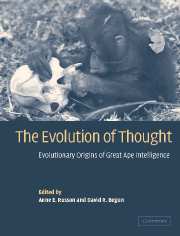Book contents
- Frontmatter
- Contents
- List of Contributors
- Preface
- 1 Evolutionary reconstructions of great ape intelligence
- 2 Enhanced cognitive capacity as a contingent fact of hominid phylogeny
- PART I COGNITION IN LIVING GREAT APES
- PART II MODERN GREAT APE ADAPTATION
- PART III FOSSIL GREAT APE ADAPTATIONS
- Part IV INTEGRATION
- Author index
- Species index
- Subject index
2 - Enhanced cognitive capacity as a contingent fact of hominid phylogeny
Published online by Cambridge University Press: 20 August 2009
- Frontmatter
- Contents
- List of Contributors
- Preface
- 1 Evolutionary reconstructions of great ape intelligence
- 2 Enhanced cognitive capacity as a contingent fact of hominid phylogeny
- PART I COGNITION IN LIVING GREAT APES
- PART II MODERN GREAT APE ADAPTATION
- PART III FOSSIL GREAT APE ADAPTATIONS
- Part IV INTEGRATION
- Author index
- Species index
- Subject index
Summary
INTRODUCTION
Relations among living great apes and humans have been worked out in recent years to the satisfaction of most researchers, from both the molecular and the morphological/fossil approaches (Begun 1999; Begun, Ward & Rose 1997; Page & Goodman 2001; Satta, Klein & Takahata 2000; Shoshani et al. 1996). It is now widely recognized that humans and Pan (chimpanzees and bonobos) are members of a clade (evolutionary lineage) to the exclusion of other living primates, and that among living apes gorillas are next most closely related, orangutans after that, and hylobatids (gibbons and siamangs) after that. The living great apes, humans, and their ancestral lineages then form a natural evolutionary group, the hominids (Table 2.1 and Figure 2.1). Where fossil hominids (Miocene to Pleistocene great apes and humans) fall within this framework is the subject of intense debate, but this question is not critical to the theme of this chapter.
Phylogenetic parsimony suggests that characteristics shared among all members of the hominid group probably evolved once in their common ancestor rather than repeatedly in the separate lineages of the Hominidae. In some cases the symplesiomorphic (shared primitive) nature of characters shared among living hominids is supported by fossil evidence, such as brain size, body mass and rate of maturation (Begun & Kordos, Chapter 14, Gebo, Chapter 17, Kelley, Chapter 15, this volume). Among the shared characteristics that cannot be directly confirmed in the fossil record is great apes' distinctive intelligence.
- Type
- Chapter
- Information
- The Evolution of ThoughtEvolutionary Origins of Great Ape Intelligence, pp. 15 - 28Publisher: Cambridge University PressPrint publication year: 2004
- 9
- Cited by



